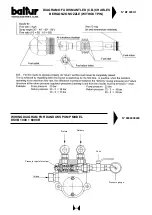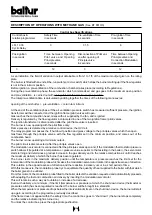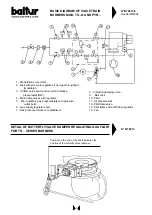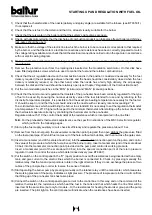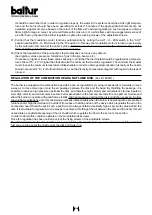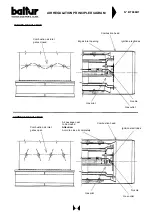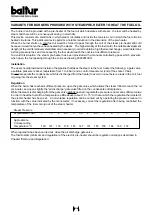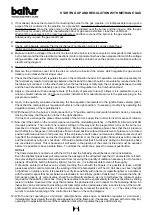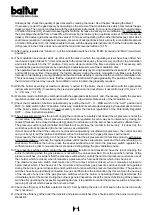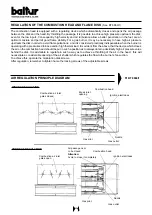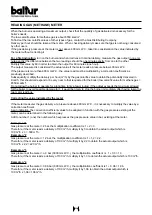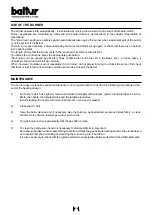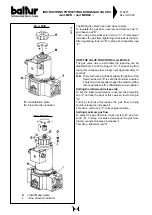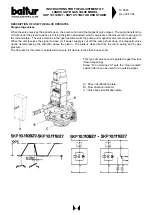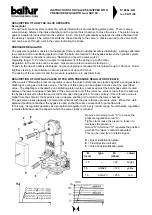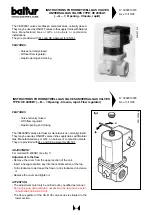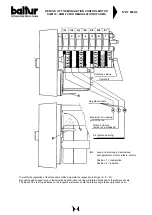
19
17) The minimum thermostat closes when the fuel contained in the pre-heater reaches the temperature at which the
thermostat has been set. When the minimum thermostat closes it does not immediately determine connection of
the burner’s control box. The control box is connected by the regulation thermostat (change over contact) when it
disinserts the resistances because the fuel temperature has reached the value at which the regulation thermostat
has been set. Therefore, the burner starts up, provided that the boiler and safety thermostats or pressure switches
are closed, only when the resistances have been disinserted and maximum temperature in the pre-heater has
been reached. When the burner is operating, an auxiliary relay (connected to the minimum thermostat) will prevent
it from coming to a standstill when the regulation thermostat changes over the contact in order to insert the
resistances again (see electric diagram). When the control box is connected, the burner will begin to carry out the
ignition phases. The programme provides a pre-ventilation phase of the combustion chamber at the same time as
a pre-circulation phase of the entire fuel circuit of the burner (with hot oil at low pressure).
Burner ignition occurs as described in the previous chapter “Description of Operations” and the burner starts up
at minimum.
UV Cell
Flame detection is carried out with the UV Cell and the following should be taken into consideration.
Even the slightest greasiness will compromise the passage of the ultraviolet rays through the UV photoelectric
cell bulb, thus preventing the sensitive internal element from receiving the quantity of radiation necessary for it to
function properly. Should the bulb be fouled by light oil, fuel oil, etc., it is indispensable to clean it thoroughly.
It should be pointed out that even by simply touching the bulb with the fingers, it is possible to leave a slight
greasiness which could compromise the working of the UV photoelectric cell.
The UV Cell does not “see” daylight or light from an ordinary lamp. It is possible to verify its sensibility with a flame
(or cigarette lighter or a candle) or with the electric spark that occurs between electrodes in an ordinary ignition
transformer. To ensure that the UV Cell works properly, its current value should be sufficiently stable so as not to
fall below the minimum value required for the specific control box. It may be necessary to search experimentally
for the best position by sliding (axial or rotation movement) the body that contains the photoelectric cell in respect
to the fastening clamp. An inspection can be carried out by inserting a microammeter, with an adequate scale, in
series to one of the two UV photoelectric cell connection wires. It is obviously necessary to respect the polarity (
+ e - ). The value of the cell current to ensure functioning of the control box is shown on the wiring diagram.
18) When the burner is operating at “minimum”, proceed with regulating the air to the quantity considered necessary
to ensure efficient combustion. Tighten more or loosen more the adjusting screws in correspondence to the point
of contact, with the lever which transmits the movement to the combustion air regulation shutter.
It is preferable that the quantity of air for the “minimum” is slightly reduced, in order to ensure a soft ignition even
in the most critical conditions.
19) After having regulated the air for the “minimum”, put the modulation switches in the “MAN” (manual) and “MAX”
(maximum) positions.
20) The modulation servomotor starts moving; wait until the disk on which the regulating screws have been fitted, has
reached an angle of about 12° (this corresponds to the space taken up by three screws), stop the modulation
motor and return the switch to the “O” position. Carry out a visual control of the flame and proceed, if necessary,
with regulating the combustion air by operating as described in point 18. Subsequently, control combustion with
the appropriate instruments and modify, if necessary, the previous regulation carried out by visual control only.
The operation described above should be repeated progressively (by moving forwards the disk by about 12° at a
time) and modifying every time, if necessary, the fuel/air ratio during the entire modulation run. Make sure that the
increase in fuel delivery occurs gradually and that maximum delivery is reached at the end of the modulation run.
This is necessary in order to ensure that modulation functions with good graduality. The positions of the screws
that command the fuel may need to be modified in order to obtain the graduality required.
Maximum delivery is obtained when the return pressure is about 2 ÷ 3 bar) less that the delivery pressure (normally
20 ÷ 22 bar). For a correct air/fuel ratio, the percentage of Carbon Dioxide (CO
2
) should increase with the increase
in delivery (about a minimum of 10% at minimum delivery to a maximum of 13% at maximum delivery).
We advise against exceeding 13% of the CO
2
to avoid operating with a rather limited excess of air which would
cause a considerable increase in smoke opacity due to unavoidable circumstances (a variation in the atmospheric
pressure; presence of dust particles in the fan’s air ducts, etc.). Smoke opacity depends on the type of fuel
utilized (the most recent provisions indicate that it should not exceed N° 6 of the Bacharach scale).
We advise, if possible, maintaining smoke opacity below N° 6 of the Bacharach scale even if, as a consequence,
the CO
2
value is slightly lower. The lower smoke opacity dirties the boiler less and therefore its average yield is
normally higher even when the CO
2
value is slightly inferior.
Summary of Contents for TS 0 GN
Page 2: ......
Page 47: ......
Page 48: ......
Page 49: ......
Page 50: ......
Page 51: ......
Page 52: ......
Page 53: ......
Page 54: ......
Page 55: ......
Page 56: ......
Page 57: ......
Page 58: ......
Page 59: ......
Page 60: ......
Page 61: ......
Page 62: ......
Page 63: ......
Page 64: ......
Page 65: ......
Page 66: ......
Page 67: ......
Page 68: ......
Page 69: ......
Page 70: ......
Page 71: ......
Page 72: ......
Page 73: ......
Page 74: ......
Page 75: ......
Page 76: ......
Page 77: ......
Page 78: ......
Page 79: ......
Page 80: ......
Page 81: ......
Page 82: ......
Page 83: ......
Page 84: ......
Page 85: ......
Page 86: ......
Page 87: ......
Page 88: ......
Page 89: ......
Page 90: ......
Page 91: ......
Page 92: ......
Page 93: ......
Page 94: ......
Page 95: ......











